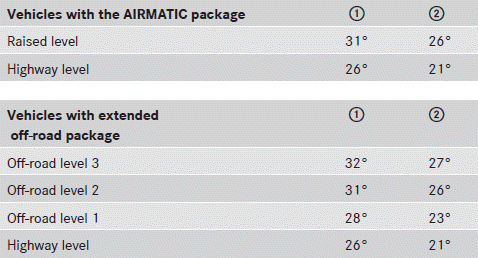Approach/departure angle

1 Approach/departure angle, front
2 Approach/departure angle, rear

Х Comply with the rules for off-road
driving.
Х Do not drive at an angle on slopes,
inclines or gradients, but instead follow the direct line
of fall. The maximum gradient-climbing capability of your vehicle is 100%, which
corresponds
to an approach/departure angle of 45∞. Note that the vehicle's gradient-climbing
capability
depends on the off-road conditions.
Х Before tackling steep downhill gradients,
select shift range 1.
Х Drive slowly.
Х Avoid high engine speeds Ц drive at a
suitable engine speed (maximum 3000 rpm).
Х Use the braking power of the engine when
driving down a slope. Observe the engine speed,
do not overrev the engine.
Х Check the brakes after driving off-road for
a long time.
WARNING ![]()
Never turn the vehicle around on steep inclines. The vehicle might roll over. If
the vehicle cannot
complete the attempted climb, back it down in reverse gear.
 Hill start assist will aid you when pulling away on a hill.
Hill start assist will aid you when pulling away on a hill.
For more information, see "Hill start assist".
See also:
Automatic transmission
WARNING
It is dangerous to shift the automatic
transmission out of parking position P or
neutral position N if the engine speed is
higher than idle speed. If your foot is not firmly
on the b ...
Mercedes-Benz M-Class Owners Manual
...
Parking
WARNING
The Parking Guidance is only an aid and may
not detect all obstacles. The Parking
Guidance does not relieve you of the
responsibility to pay attention. You are always
responsible fo ...
